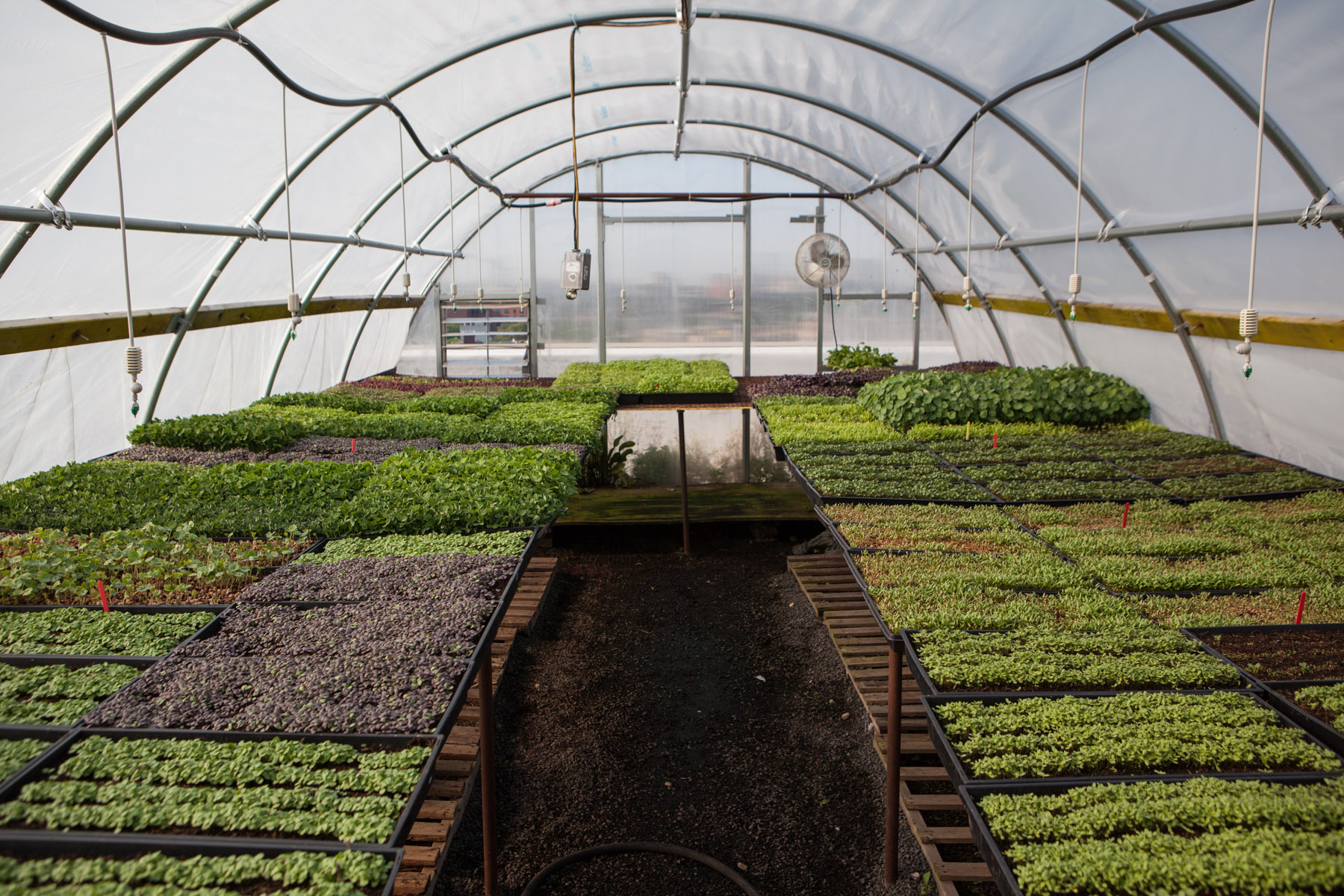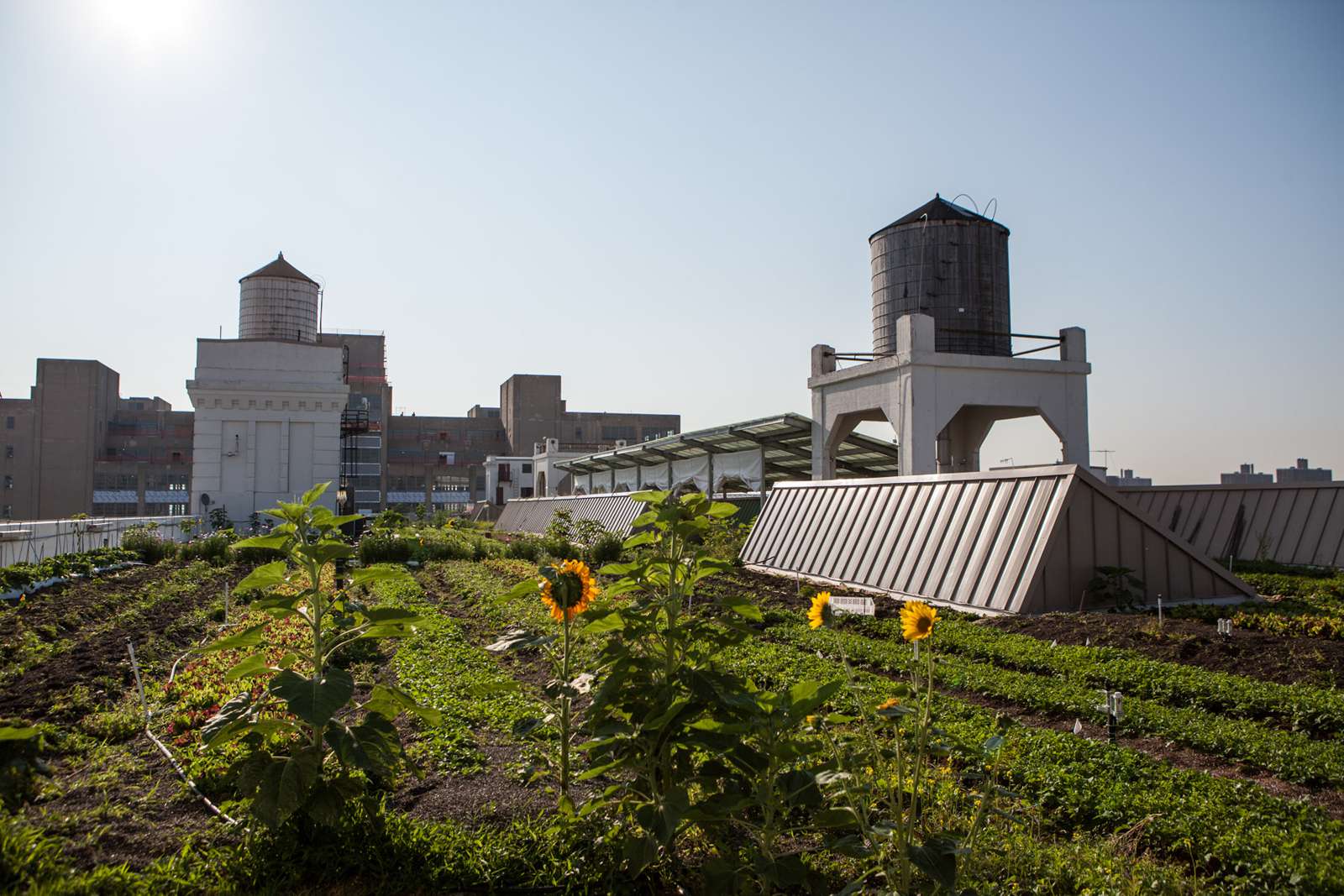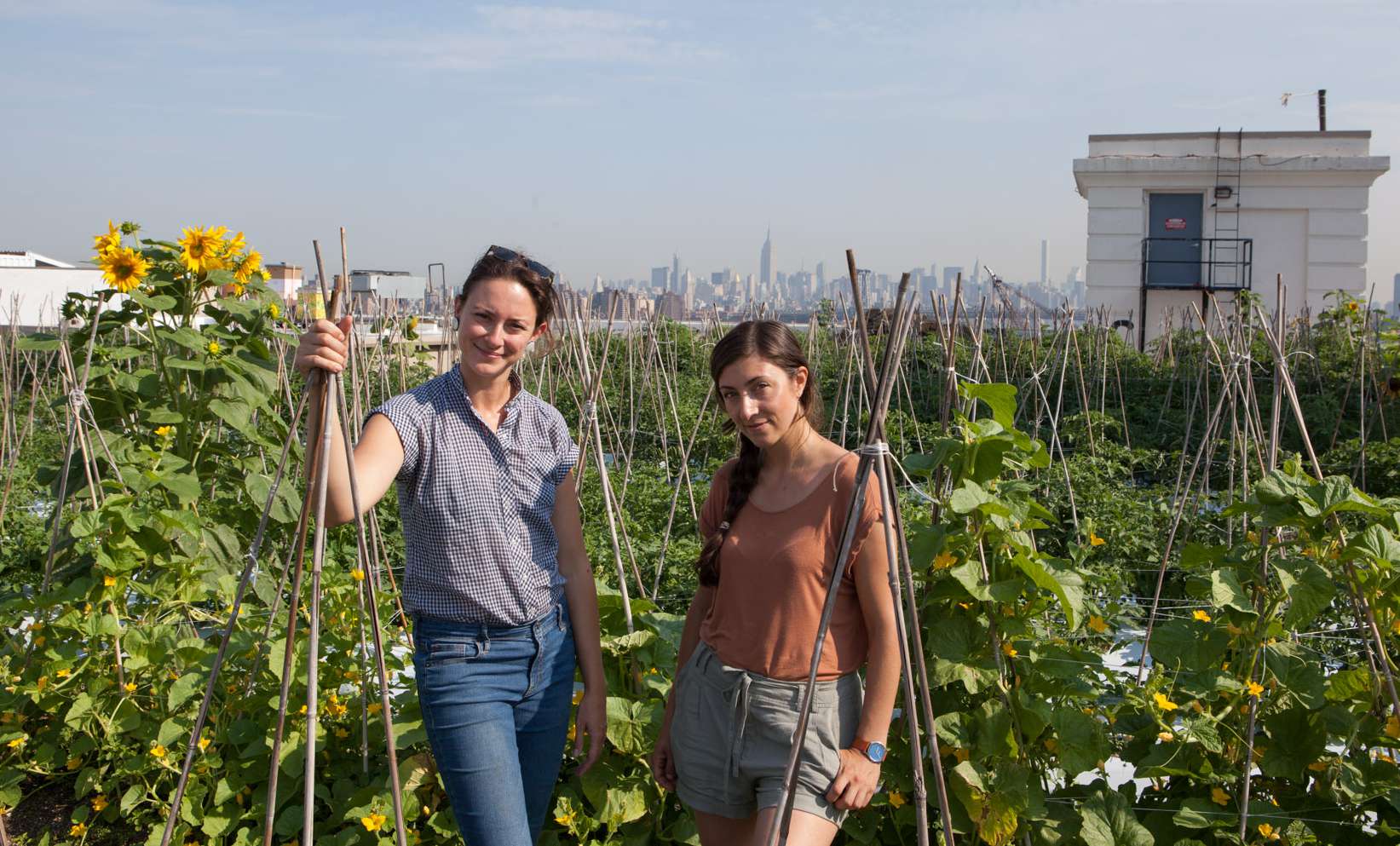It’s a sweltering summer day on the farm. Bees buzz by as kale, tomatoes, zucchini, arugula, and beets grow under the bright sun. The smell of earth mixes with the sweet smell of fresh herbs and flowers. A glance around reveals a few greenhouses, a chicken coop, and plenty of lush green. What makes this farm unique? An amazing view of the Manhattan skyline.
This is Brooklyn Grange’s home base, a 1.5-acre rooftop farm that sits atop an 11-story building in the Brooklyn Navy Yard. It’s the brainchild of Chief Operating Officer Gwen Schantz ’03 and Vice President Anastasia Cole Plakias ’05, who started urban farming in New York City in 2010.

“I always wanted to spend most of my time in the city doing gardening work,” says Schantz. She spoke to the Vassar Quarterly on a Thursday—harvest day. That means farm managers arrive by 7:00am to begin a long day of picking, washing, and packaging fresh vegetables for immediate delivery to nearby restaurants and markets. A pair of triple-basin stainless steel sinks and a washing machine set on the spin cycle—like an extra-large salad spinner—are engaged throughout the morning and afternoon. The hurried pace is necessary to get the produce to customers as quickly as possible.

“Almost all of our food is consumed within a couple of miles of the farm,” Schantz says.
But the first Brooklyn Grange farm wasn’t in the borough of Brooklyn; it started on a roof in Long Island City, Queens. The idea was to bring the farm-to-table concept to New York City, not as a nonprofit, Plakias says, but as a lucrative business that followed three Ps: profit, planet, and people.
The idea for that first farm was born of a chance meeting in the Bushwick neighborhood of Brooklyn, at a restaurant called Roberta’s, known for its fresh food and eccentric ambiance. Schantz was making pizzas at the eatery, and Plakias was a visiting journalist looking to do a story on the garden Roberta’s was creating in a vacant lot next door.
“It was full of old car parts and dead cats—all sorts of mysterious things,” Schantz says. “I helped them to clean it out and convert it into a garden and an events space.”
When the garden work got underway, it was impossible to simply sit on the sidelines, so Plakias put down her pen and picked up a shovel.

“As soon as we had completed the first of two gardens we built for Roberta’s, I was hooked,” she says. “I’d spent a lifetime observing, analyzing, and commenting, and it was the first time I’d actually taken more action than thought.”
With Ben Flanner—now CEO and Director of Agriculture of Brooklyn Grange—the trio set out in fall 2009 to gain financing and find a location for a rooftop farm. Flanner had crunched the numbers and determined that a minimum size of 30,000 square feet was needed to turn a profit. They found a 45,000-square-foot roof in Long Island City, and by May 2010, the farm was up and running. They haven’t looked back since.
“The public support for this project was incredible, and we knew there was room to grow,” Schantz says.
Two years later, Brooklyn Grange was approached by officials at the Brooklyn Navy Yard who offered the use of a rooftop and a chance to partner on $600,000 in funding from the Department of Environmental Protection’s Green Infrastructure Grant Program. This roof, at 65,000-square-feet—about 1.5 acres—became their largest project.
“It’s a pretty big footprint compared to other farms in New York City,” Schantz says.
Brooklyn Grange received funding for a third site, also in Brooklyn, through the DEP grant program and is expected to begin construction in spring 2017.
Building a farm on a rooftop is a gargantuan effort. Of paramount importance is the engineering of the structure—can it hold thousands of tons of wet soil? A structural engineer has to be called in to analyze any building being considered for a farm, Schantz says. Fortuitously, the Brooklyn Navy Yard building was ideal for their purposes.
“These old industrial buildings are about 100 years old and incredibly robust. They have a lot of internal columns, thick concrete slabs, and rebar steel reinforcement,” Schantz says.
After waterproofing the surface with rubber, the farm was designed. Gravel was laid for drainage, followed by a felt filter fabric. Four-inch high metal edging was used to create plots for the soil and concrete paving stones were used for walkways. Then came the fun part: getting three million pounds of soil onto the roof. Ingenuity ruled the day; they decided to use an industrial pump to draw soil up from trucks on the ground directly onto the roof—think of it as an 11-story straw.
The farm took about a month to build, and, since then, they’ve added two greenhouses to grow seedlings and microgreens (which are sold to area restaurants), a chicken coop, composting heaps, and several beehives.
To boost profits, Brooklyn Grange tries to get as many growing seasons in as possible, starting in May with turnips, radicchio, snap peas, and other vegetables. In the summer they grow cucumbers, tomatoes, peppers, zucchini, and more—including lots of salad greens. Their final harvest, in November, yields eggplant, radishes, carrots, and chard. In order to foster such intense growth, they use nutrient-rich soil that includes composted materials, biochar (charcoal produced from plants), and organic fertilizer.

“There’s a lot of seasonal variation, but our cash crop is the salad greens. It’s the bulk of what we grow and we sell those primarily to restaurants in large quantities,” Schantz says.
Brooklyn Grange also hosts dinners and parties on the rooftop, where they recently installed a 2,000-square-foot awning strung with sparkling tea lights—a nice accompaniment to the lights of Manhattan and Brooklyn.
The company’s farms have been so well received that they’ve consulted for people around the world and have designed and installed rooftop farms, green infrastructure—such as green walls—and other projects throughout the city and beyond.
“It says a lot about NYC and how supportive the city is to local food and sustainable farming,” Schantz says.
Students from area schools have been visiting the farm since its inception and have found it especially inspiring, she adds. At first Brooklyn Grange offered educational tours and workshops, but the endeavor became a bit overwhelming. Still, Plakias and Schantz felt sharing their knowledge was important, especially for students in schools that could least afford the field trips to the farm, so in 2011 they created the nonprofit City Growers.

Run by Executive Director Cara Chard ’04 and Deputy Director Elizabeth Pierson ’03, City Growers brings students from area schools to the farm, educating them on food sources, farming, and other related subjects. Since its inception, the nonprofit has brought 24,000 students to the farm, Plakias says.
“It’s great to see these kids coming up and experiencing the farm and getting excited about it. As a New York City public school kid, it gives me a ton of joy,” she says.
“They can place themselves in a world that has green roofs and farms and maybe have a more optimistic vision of New York City and cities in general,” Schantz says.
Plakias has shared what they’ve learned about urban farming in her book The Farm on the Roof: What Brooklyn Grange Taught Us about Entrepreneurship, Community, and Growing a Sustainable Business!
Whether through a few tomato plants on apartment balconies or community and rooftop gardens, urban farming brings about an opportunity to connect a diverse community to the food they consume, Plakias says.
